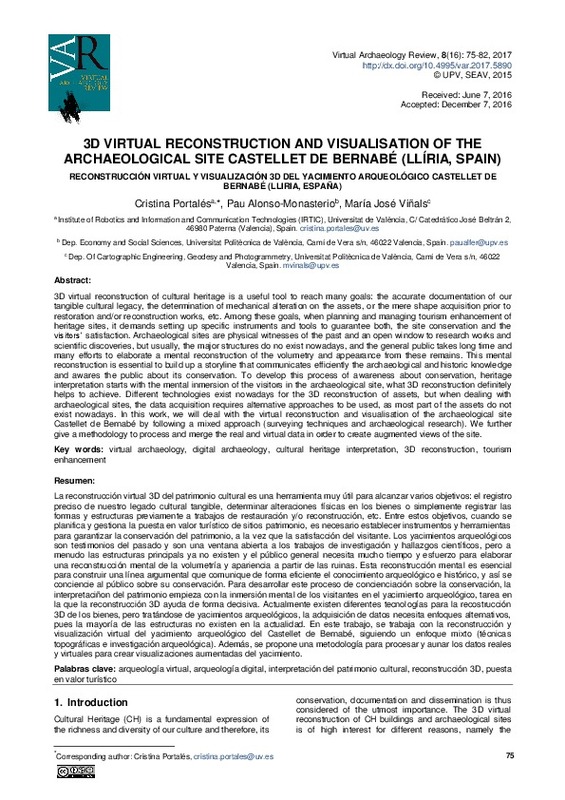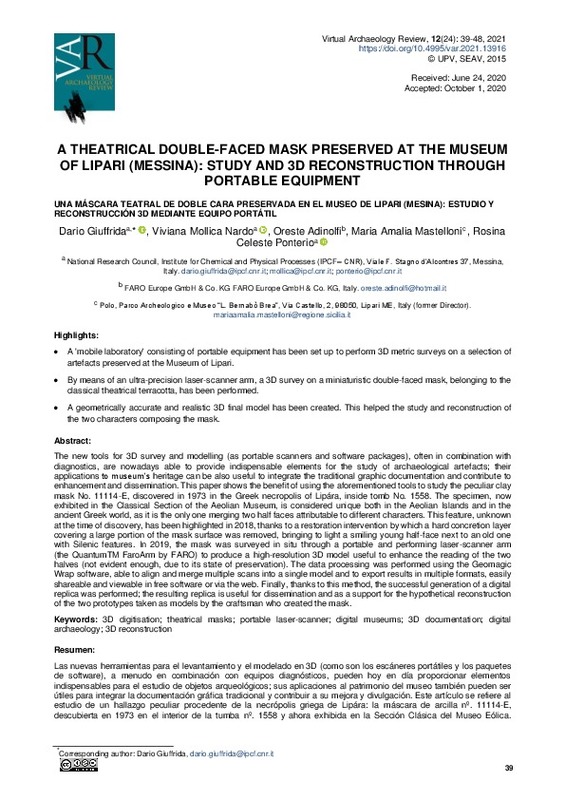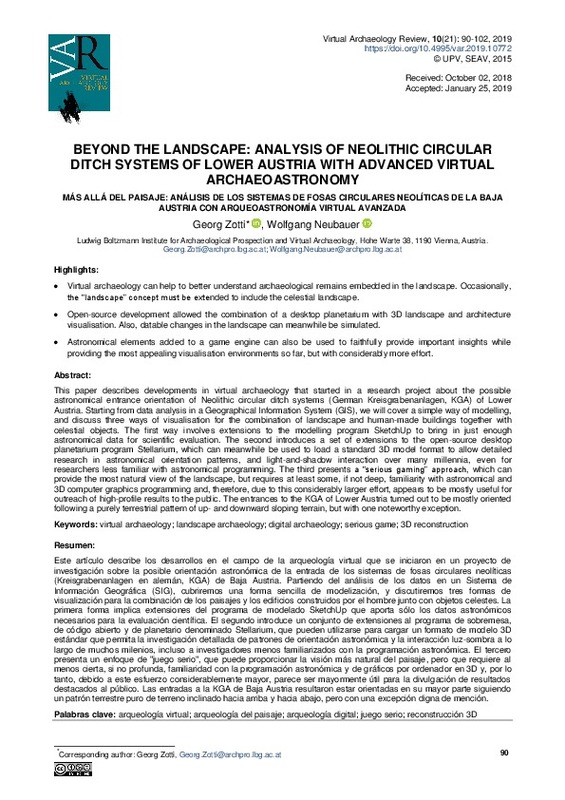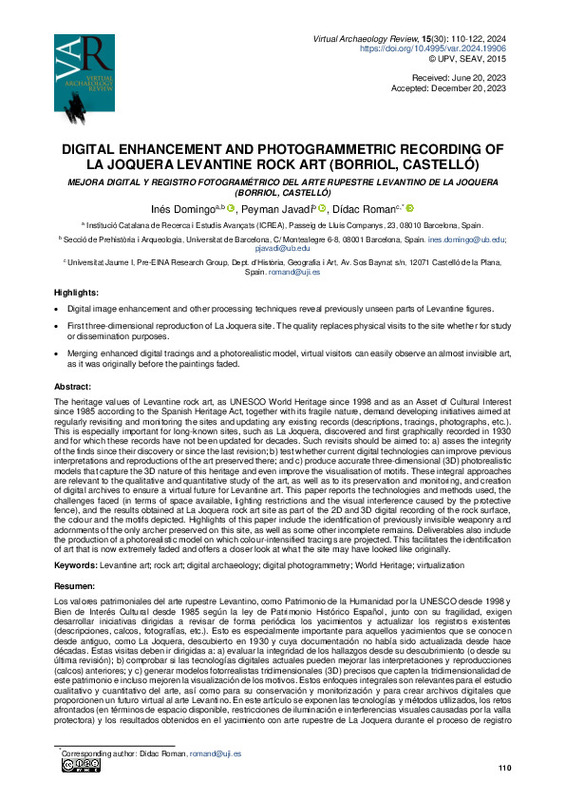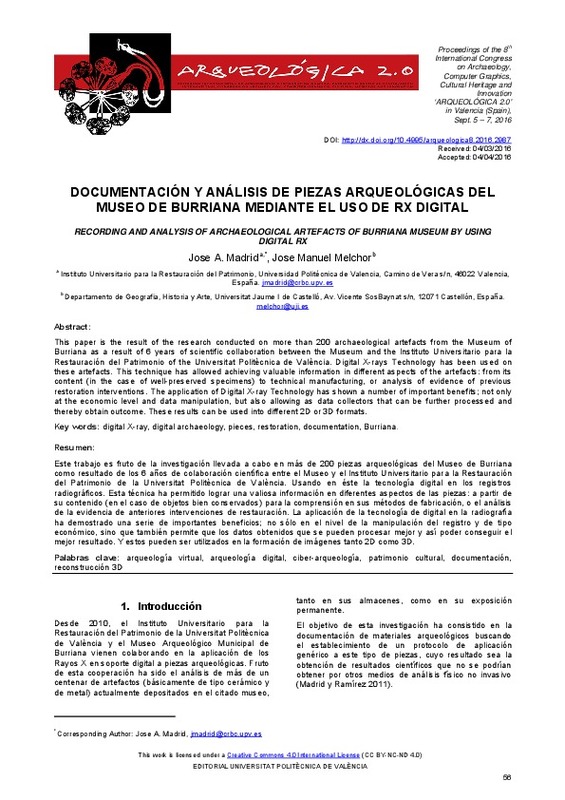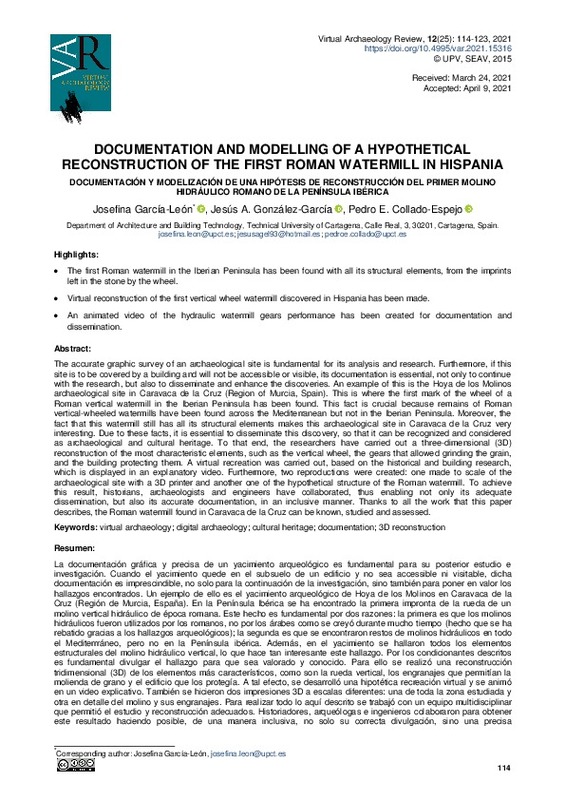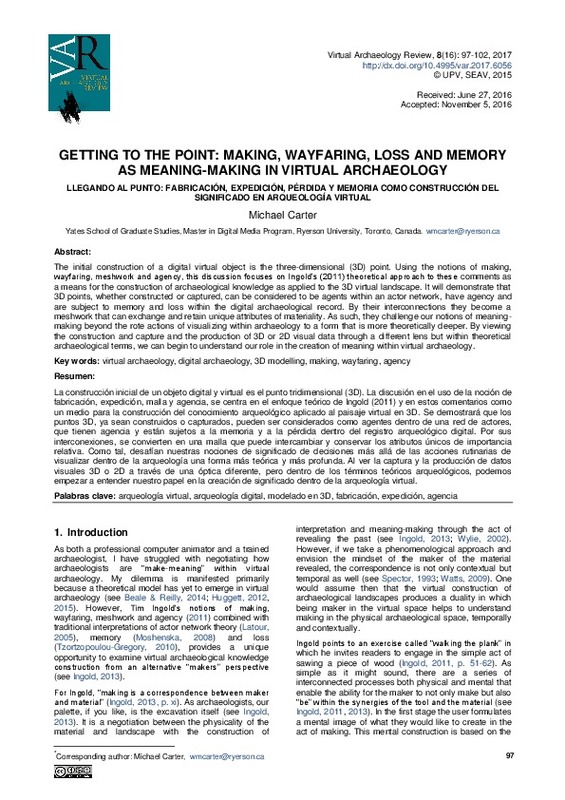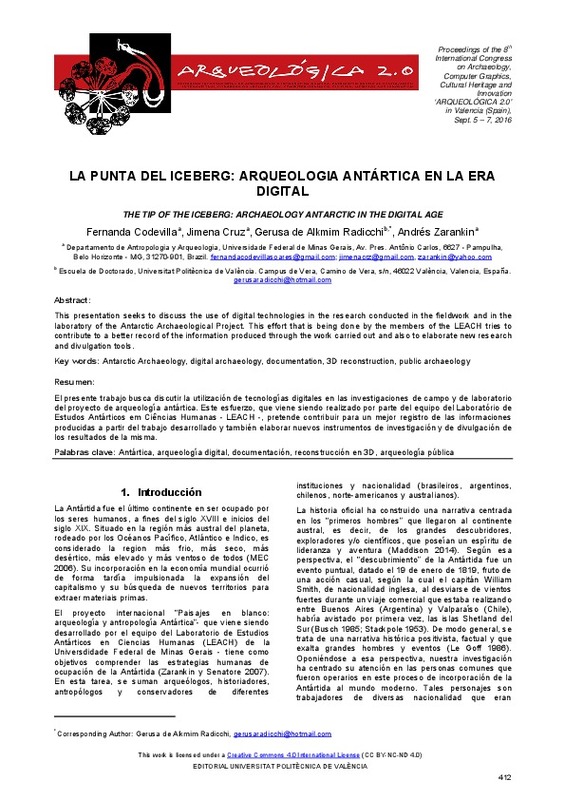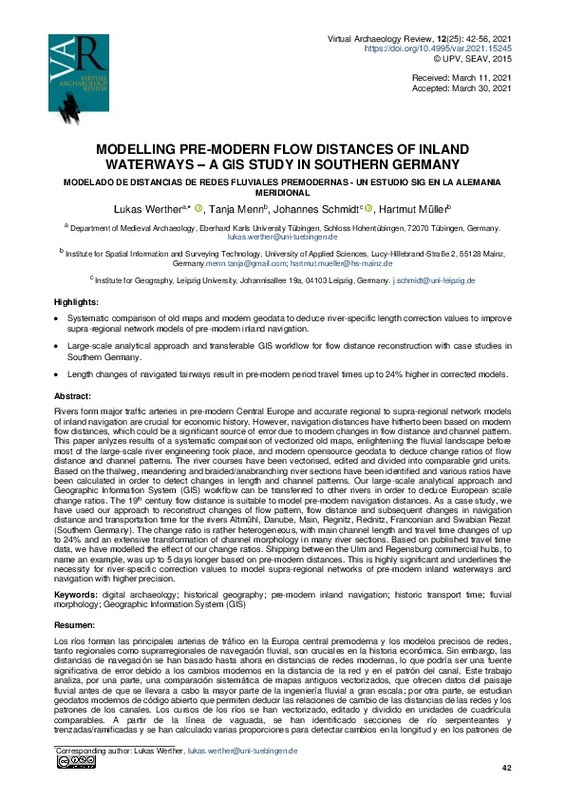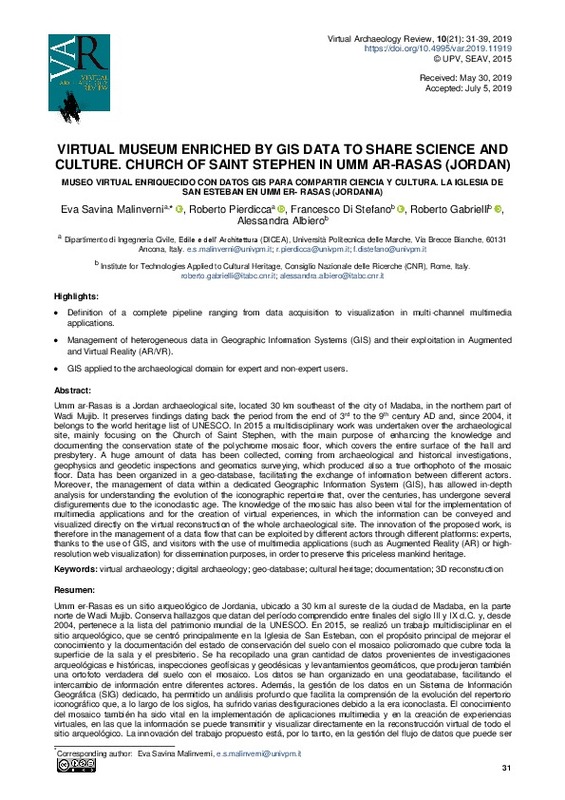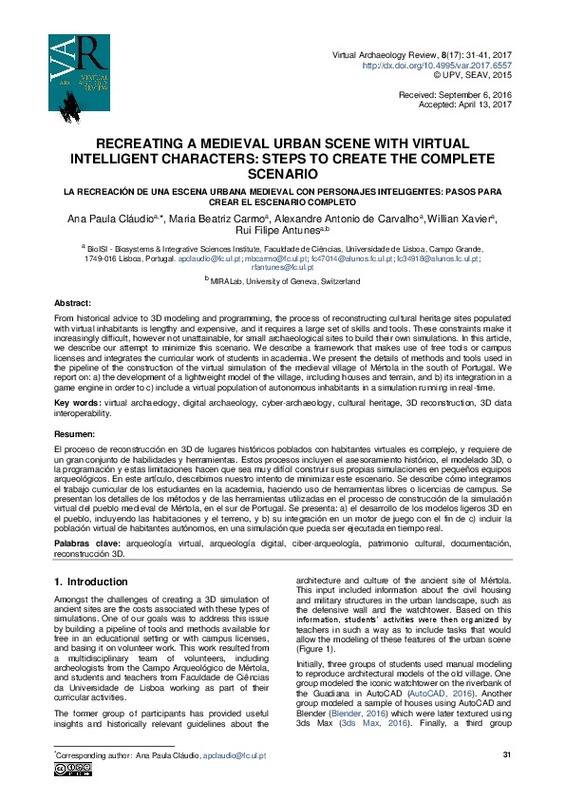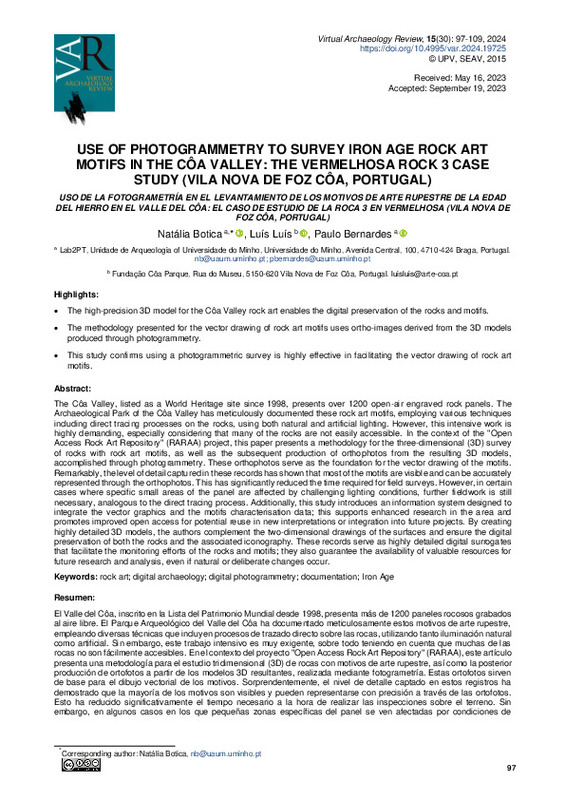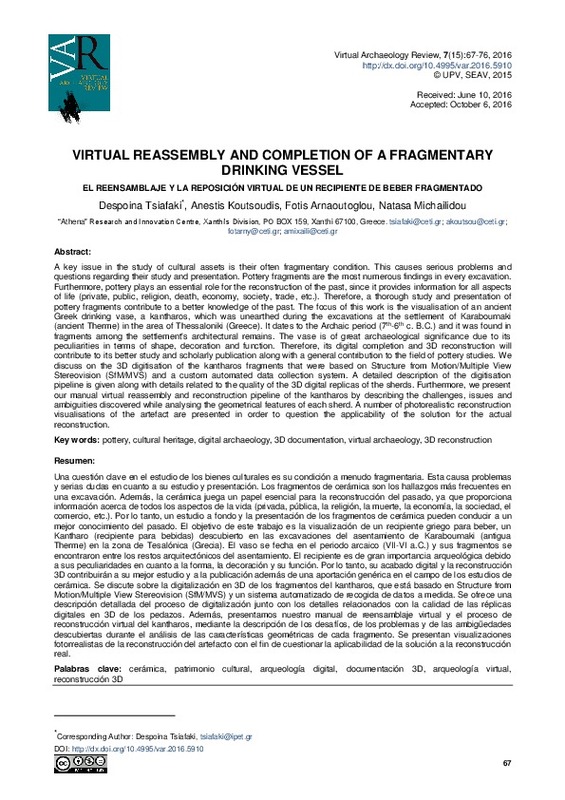

Listar por palabra clave "Arqueología digital"
RiuNet: Repositorio Institucional de la Universidad Politécnica de Valencia
- RiuNet repositorio UPV
- :
- Listar por palabra clave
JavaScript is disabled for your browser. Some features of this site may not work without it.
Buscar en RiuNet
Listar
Mi cuenta
Ayuda RiuNet
Admin. UPV
Listar por palabra clave "Arqueología digital"
Mostrando ítems 1-20 de 20
-
Portalés, Cristina; Alonso-Monasterio, Pau; Viñals, María José (Universitat Politècnica de València, 2017-05-22)[EN] 3D virtual reconstruction of cultural heritage is a useful tool to reach many goals: the accurate documentation of our tangible cultural legacy, the determination of mechanical alteration on the assets, or the mere ...
-
Giuffrida, Dario; Mollica Nardo, Viviana; Adinolfi, Oreste; Mastelloni, Maria Amalia; Ponterio, Rosina Celeste (Universitat Politècnica de València, 2021-01-19)[EN] The new tools for 3D survey and modelling (as portable scanners and software packages), often in combination with diagnostics, are nowadays able to provide indispensable elements for the study of archaeological ...
-
Zotti, Georg; Neubauer, Wolfgang (Universitat Politècnica de València, 2019-07-25)[EN] This paper describes developments in virtual archaeology that started in a research project about the possible astronomical entrance orientation of Neolithic circular ditch systems (German Kreisgrabenanlagen, KGA) of ...
-
Domingo, Inés; Javadi, Peyman; Roman, Dídac (Universitat Politècnica de València, 2024-01-19)[EN] The heritage values of Levantine rock art, as UNESCO World Heritage since 1998 and as an Asset of Cultural Interest since 1985 according to the Spanish Heritage Act, together with its fragile nature, demand developing ...
-
Madrid García, José Antonio; Melchor, Jose Manuel (Editorial Universitat Politècnica de València, 2016-10-27)[EN] This paper is the result of the research conducted on more than 200 archaeological artefacts from the Museum of Burriana as a result of 6 years of scientific collaboration between the Museum and the Instituto ...
-
García-León, Josefina; González-García, Jesús Á.; Collado-Espejo, Pedro E. (Universitat Politècnica de València, 2021-07-14)[EN] The accurate graphic survey of an archaeological site is fundamental for its analysis and research. Furthermore, if this site is to be covered by a building and will not be accessible or visible, its documentation is ...
-
Carter, William Michael (Universitat Politècnica de València, 2017-05-22)[EN] The initial construction of a digital virtual object is the three-dimensional (3D)point. Using the notions of making, wayfaring, meshwork and agency, this discussion focuses on Ingold’s (2011) theoretical approach to ...
-
Codevilla, Fernanda; Cruz, Jimena; De Alkmin Radicchi, Gerusa; Zarankin, Andres (Editorial Universitat Politècnica de València, 2016-10-27)[EN] This presentation seeks to discuss the use of digital technologies in the research conducted in the fieldwork and in the laboratory of the Antarctic Archaeological Project. This effort that is being done by the members ...
-
Werther, Lukas; Menn, Tanja; Schmidt, Johannes; Müller, Hartmut (Universitat Politècnica de València, 2021-07-14)[EN] Rivers form major traffic arteries in pre-modern Central Europe and accurate regional to supra-regional network models of inland navigation are crucial for economic history. However, navigation distances have hitherto ...
-
Giuffrida, Dario; Martinelli, Maria Clara; Armetta, Francesco; Saladino, Maria Luisa; Ponterio, Rosina Celeste (Universitat Politècnica de València, 2023-04-04)[EN] This paper presents a multidisciplinary study combining photogrammetry, near-infrared (NIR) imaging and archaeological analysis to analyse a 1900-1800 BC engraved cup, found at the Bronze Age site of Filo Braccio in ...
-
Malinverni, Eva Savina; Pierdiccaa, Roberto; Di Stefano, Francesco; Gabrielli, Roberto; Albiero, Alessandra (Universitat Politècnica de València, 2019-07-25)[EN] Umm ar-Rasas is a Jordan archaeological site, located 30 km southeast of the city of Madaba, in the northern part of Wadi Mujib. It preserves findings dating back the period from the end of 3rd to the 9th century AD ...
-
López Palacios, Abelardo (Editorial Universitat Politècnica de València, 2023-04-25)[ES] Desde finales del sigo XX, momento en que se populariza el uso y aplicación de los diferentes componentes que proporcionan los avances tecnológicos, con la conjunción del «Periodo de la computación», «Periodo de la ...
-
Aparicio-Resco, Pablo; García Álvarez-Busto, Alejandro; Muñiz-López, Iván; Fernández-Calderón, Noelia (Universitat Politècnica de València, 2021-07-14)[EN] The virtual reconstruction of a site is the mirror in which the archaeological research process is reflected, with all its uncertainties and certainties, generating a space for reflection on the lost materiality while ...
-
Cláudio, Ana Paula; Carmo, Maria Beatriz; de Carvalho, Alexandre Antonio; Xavier, Willian; Antunes, Rui Filipe (Universitat Politècnica de València, 2017-07-26)[EN] From historical advice to 3D modeling and programming, the process of reconstructing cultural heritage sites populated with virtual inhabitants is lengthy and expensive, and it requires a large set of skills and tools. ...
-
Staropoli, Laura; Acevedo, Verónica Judith; Ávido, Daniela Noemí; Vitores, Marcelo (Universitat Politècnica de València, 2023-07-28)[ES] El avance de las tecnologías digitales y la virtualización favoreció el uso de nuevas herramientas para el registro, representación, conservación y puesta en valor de materiales y yacimientos arqueológicos; además, ...
-
Moya-Olmedo, Pilar (Universitat Politècnica de València, 2023-07-28)[ES] A finales de la Edad Media en la península ibérica la historia fue impulsora de una arquitectura en evolución hacia soluciones más racionales y eficientes. Entre los agentes promotores de este cambio, destacaron las ...
-
Borrero L., Ricardo; Schwindingera, Patricia; Castelli, Ana; Ciarlo, Nicolas C.; Torres, Rodrigo; Manders, Martijn; Castro, Filipe; Furuta, Richard (Universitat Politècnica de València, 2021-01-19)[EN] Data sharing is a fundamental process for the advancement of both natural and social sciences. Starting from the idea that computers and the internet have drastically changed the world in the last decades, this paper ...
-
Caro, Jose (Editorial Universitat Politècnica de València, 2016-10-27)[EN] The University of Malaga has been excavating since 2008 at the Archaeological Complex of Perdigões. The incorporation of 3D technologies to archeology is now a fact and in this project has been used. This article ...
-
Botica, Natália; Luís, Luís; Bernardes, Paulo (Universitat Politècnica de València, 2024-01-19)[EN] The Côa Valley, listed as a World Heritage site since 1998, presents over 1200 open-air engraved rock panels. TheArchaeological Park of the Côa Valley has meticulously documented these rock art motifs, employing various ...
-
Tsiafaki, Despoina; Koutsoudis, Anestis; Arnaoutoglou, Fotis; Michailidou, Natasa (Universitat Politècnica de València, 2015-11-15)[EN] A key issue in the study of cultural assets is theiroften fragmentary condition. This causes serious problems and questions regarding theirstudy and presentation. Pottery fragments are the most numerous ...
Mostrando ítems 1-20 de 20

Universitat Politècnica de València. Unidad de Documentación Científica de la Biblioteca (+34) 96 387 70 85 · RiuNet@bib.upv.es


